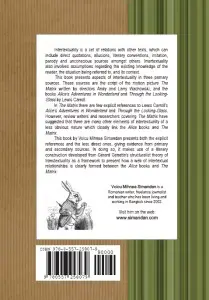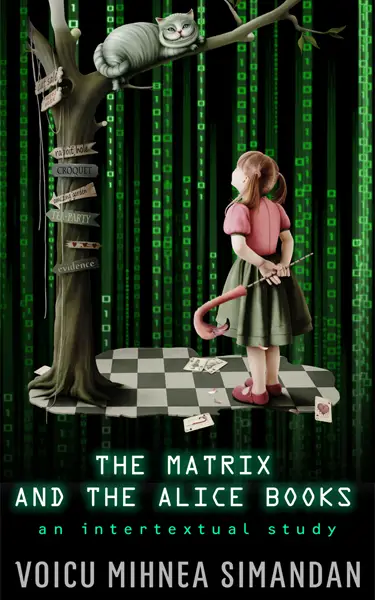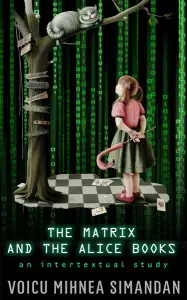In The Matrix and the Alice Books (Lulu Books, 2010), Voicu Mihnea Simandan demonstrates through quotations and examples that there are numerous aspects of intertextuality in the Alice books and The Matrix. Reference was been made to thematic, character and dreamworld intertextualities.
Chapter Four, entitled Down the Rabbit Hole, The Matrix Has You begins with an “Introduction” that states that there are elements of intertextuality between the Alice books and The Matrix. It also explains the organization of the analytical chapter according to themes, and the way Gérard Genette’s categories of transtextuality interact with the themes to create some meaning.
The second section of Chapter Four is entitled “The dream worlds” and is comprised of two subsections, i.e. Wonderland and dreamworld, and Dream and reality.
The subsection entitled “Wonderland and dreamworld” gives examples of architextuality as proposed by Genette in Palimpsests: Literature in the Second Degree (1997). Architextuality deals with the designation of a text as part of a genre or genres. In this case, the genres are fantasy and science fiction. What connects these genres are the literary conventions that all genres are based upon, such as: the setting (the wonderland and the dreamworld), point of view, the particular rules that govern reality in the worlds described, and the presence of good and bad characters. The Alice books and The Matrix are part of different genres, but have similar conventions and thus can be compared with each other.
The subsection entitled “Dream and reality” also shows that there are intertextual relationships between the Alice books and The Matrix. Metatextuality as part of Genette’s subtypes of transtextuality refers to both explicit and implicit references of one text on another. The examples of implicit references described in this subsection are references to the Alice books in terms of the themes that The Matrix tries to get across to its viewers. These themes are: dreams, reality, memory, and backward worlds.
The meaning of these themes is basically the same in both the Alice books and The Matrix. Both Alice and Neo live in a world of dreams they try so hard to understand. At the same time they both have difficulties in understanding what reality is. They are either made to believe or discouraged from believing that their experiences in the wonderland and dreamworld are real, thus trying to erase from their memory the existence of another, real, world, a world different from the backward world they find themselves in.
The third section of Chapter Four is entitled “Down the rabbit hole” and is comprised of the following subsections: Waking up from the dreamworld, The White Rabbit, Alice in wonderland, and Through the mirror.
The subsection entitled “Waking up from the dreamworld” presents a subtype of intertextuality that encompasses direct quotations, and allusion, as theorized by Genette in The Architect: An Introduction (1992). “Wake up, Neo” is a direct quotation from the Alice books that was used with the same meaning by the Wachowski brothers in The Matrix. This quotation is used at a crucial moment in the film, when Neo is about to find out that he has been living in a dreamworld, just like Alice. The message of the film is conveyed through its association with the Alice books, particularly Alice’s experience in wonderland.
 The subsection entitled “The White Rabbit” deals with paratextuality, the relation between a text and that which surrounds the main body of the text, such as titles, prefaces, illustrations, or captions. Genette refers to these in his Paratexts: Thresholds of Interpretation (1997). When first published, the Alice books were attractively illustrated and almost all subsequent editions had images depicting important moments from Alice’s adventures.
The subsection entitled “The White Rabbit” deals with paratextuality, the relation between a text and that which surrounds the main body of the text, such as titles, prefaces, illustrations, or captions. Genette refers to these in his Paratexts: Thresholds of Interpretation (1997). When first published, the Alice books were attractively illustrated and almost all subsequent editions had images depicting important moments from Alice’s adventures.
Carroll probably carefully considered the placing of the White Rabbit’s illustration at the very beginning of Alice’s Adventures in Wonderland. Not only does this illustration foreshadow the events to come, but it also remains in the readers’ minds as one of the many motives the Alice books are associated with.
In The Matrix, the White Rabbit, in the form of a tattoo on the shoulder of a minor character, is used to facilitate Neo’s introduction to the real world, and the truth about the dreamworld. In the same manner, the White Rabbit in Alice’s Adventures in Wonderland introduces Alice to the wonderland. This reference to the Alice books is used with the same meaning in The Matrix.
The illustration on Dujour’s shoulder triggers the viewer’s background knowledge of Alice’s experiences before entering wonderland down the rabbit hole. The viewer of the film might thus imagine how Neo feels at the moment of his unplugging from the Matrix. “Alice was beginning to get very tired of sitting by her sister on the bank…” wrote Carroll in Alice’s Adventures in Wonderland while Neo has “the feeling where you don’t know if you’re awake or still dreaming” (Larry and Andy Wachowski, The Matrix: Script, 1999).
The intertextuality involved in the subsection entitled “Alice in wonderland” is an explicit reference from Alice’s Adventures in Wonderland in the film The Matrix. According to Genette, explicit references are part of metatextuality. In Genette’s own words, metatextuality: “unites a given text to another, of which it speaks without necessarily citing it”. There is only one such explicit reference, and that refers to Alice and the wonderland she traveled into.
The Wachowski brothers tried to maintain in The Matrix a sense of awe and curiosity that can be noticed in the Alice books. If the viewer of The Matrix thinks of how Alice felt when she followed the White Rabbit and then jumped after him down the rabbit hole, then s/he might better understand how Neo felt when he was offered the choice of finding out what the Matrix actually is. They were both intrigued by the extraordinary events that had only recently happened in their lives. Alice saw a talking rabbit with a waistcoat and a watch, while Neo was arrested by three mysterious men that seemed to know everything about him.
 The subsection entitled “Through the mirror” presents intertextuality in the form of allusions. Genette’s first subtype of transtextuality is intertextuality, which includes among others, allusion too. The allusions used in The Matrix from the Alice books refer to two motives; the mirror and water.
The subsection entitled “Through the mirror” presents intertextuality in the form of allusions. Genette’s first subtype of transtextuality is intertextuality, which includes among others, allusion too. The allusions used in The Matrix from the Alice books refer to two motives; the mirror and water.
The motive of the mirror as a means of passing into a different world was borrowed by the directors of The Matrix from Through the Looking-Glass by Lewis Carroll. Alice walks through a mirror into wonderland, while Neo is consumed by a fluid-like mirror only to wake up in the real world. At the entrance to the wonderland and the real world, Alice and Neo fall down a hole or tube, only to find themselves surrounded by water. Alice and Neo go through a symbolic baptism that “welcomes” them into new worlds. By using allusions to the Alice books, the Wachowski brothers succeed in making the message of the movie very clear, indeed; i.e. the existence of worlds within worlds and the idea of rebirth.
The fourth section of Chapter Four is entitled “The rite of passage” and is comprised of the following subsections: Alice and Neo, Double identity, and Growth in adulthood / the One.
The subsection entitled “Alice and Neo” shows that intertextuality exists between the Alice books and The Matrix at the level of their main characters too. Genette’s hypertextuality refers to the relation between a text and another text on which the first text is based, but which it transforms. This is the case of Alice and Neo. Both characters are similar in that they both enter a world within a world where they have life-changing experiences. Nevertheless, although Neo follows the footsteps of Alice, the directors of The Matrix transformed his character into a far more complex one.
Both Alice and Neo start their journey with little knowledge of what the world they have discovered is all about, but walk out of it with the ability to change and improve it.
The subsection entitled “Double identity” presents allusions that refer to the theme of double identity. The references to the Alice books are used with the same meaning in The Matrix. Both Alice and Neo lead a double life, one in the dreamworld and one in the real world, and at times they have difficulty in realizing which world they live in. To better understand The Matrix and the two worlds Neo lives in, one just has to reverse Alice’s situation. Alice’s dreamworld is underground and she experiences it while asleep. Neo’s dreamworld is aboveground, and he experiences it by taking the red pill that enables Morpheus’s crew to wake him up from his pod. Alice and Neo live two lives, one in their dreams and one in the real world. They both have double identities.
The last subsection entitled “Growth in adulthood / the One” describes implicit references that allude to details from The Matrix not stated in the Alice books, such as growth into adulthood / the One, self-awareness, choices and regrets.
These thematic congruencies are straight-forward, being used with the same meaning in The Matrix as in the original Alice books. Both characters go through a rite of passage that eventually will lead them to adulthood in Alice’s case, and, in the film’s case, to the realization that Neo is the One, and the Matrix is not real. The message of The Matrix is better conveyed if the viewer has in mind the challenges Alice has to go through in her wonderland, and then juxtaposes them with what Neo faces in the movie.
The Wachowski brothers have brought together in The Matrix a variety of themes and ideas from the Alice books. They felt that there was something in them to make the viewer better connect with the worlds they were trying to portray. The writers of the script used the references to the Alice books by both using the same meaning and as a springboard for other interpretations.
Even though differences between The Matrix and the Alice books exist there are many striking similarities. The Wachowski brothers attribute this to the desire to convey that the Matrix is a lot like the wonderland experienced by Alice. The directors were able to take themes and motives from the Alice books and tightly weave them into The Matrix, thus creating their own wonderland, with so many touches of originality.
It is in the similarities and differences between the Alice and The Matrix references, in their interaction with the works’ various themes, that the significance of the journeys or rites of passage of the two characters which emerges fully. Without studying the intertextualities in detail, as I have done in this study, the viewer of the film would undoubtedly be able to respond intuitively to the movie’s message. However, this careful analysis at one area of the film’s complex web of intertextuality definitely allows for the articulation of meanings that would have otherwise remained at best as inklings in the moviegoer’s mind.
Down the rabbit hole, the Matrix has you!
My intertextual study The Matrix and the Alice Books looks at the way Lewis Carroll’s Alice’s Adventures in Wonderland and Through the Looking-Glass have influenced some of the ideas put forth by Andy and Larry Wachowski. The book is now available as a Kindle ebook too.



Wow, Mihnea, this is real comparative lit thinking, could be a great idea for a PhD thesis! I’d have never thought of this, but it is a very interesting concept.
Thanks Pete for your kind comment. The idea of the book actually came to me while I was doing my MA at ABAC in Bangkok.
Hello , I have a question concerning Genette’s definition of genre please !
as far as I read Genette means with genre common points in terms of themes , structure , style , setting…
Now can we consider Tragedy as a genre ? Because I am working on a comparison between the Iliad and The Godfather, can I say that a common genre between them is tragedy ? I did prove that both heroes are tragic , but concerning the genre I’m confused .thank you !